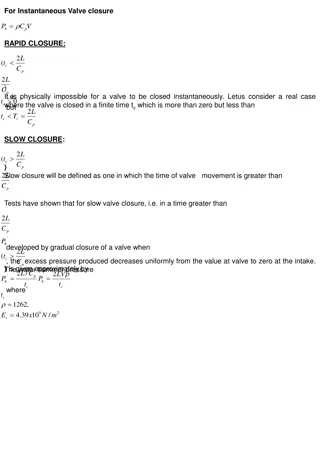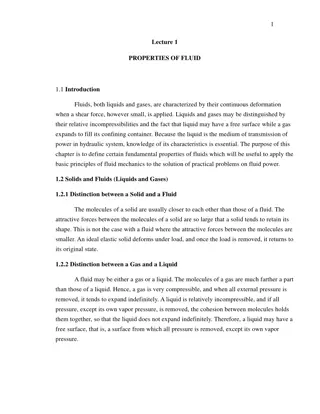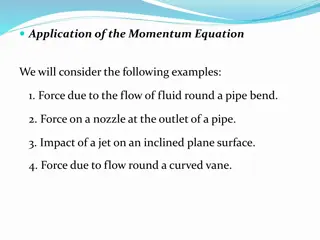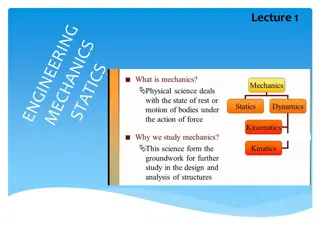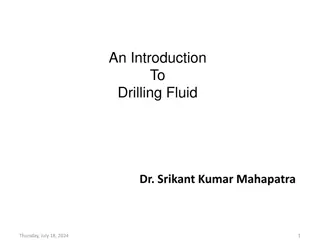Understanding Non-Dimensional Numbers in Fluid Mechanics
Non-dimensional numbers play a crucial role in understanding fluid motion. This includes Reynolds Number for inertia and viscous forces, Froude Number for gravity effects, Cauchy Number for compressible flows, and Mach Number for elasticity forces. These numbers help in analyzing pipe friction, flow patterns, and design of various fluid systems. By delving into the significance of these non-dimensional numbers, engineers and scientists can make informed decisions in fluid mechanics applications.
Download Presentation

Please find below an Image/Link to download the presentation.
The content on the website is provided AS IS for your information and personal use only. It may not be sold, licensed, or shared on other websites without obtaining consent from the author. Download presentation by click this link. If you encounter any issues during the download, it is possible that the publisher has removed the file from their server.
E N D
Presentation Transcript
Non Dimensional Numbers in Motion of Fluids and their Significance Fluid Mechanics (DTE 112) Dr. J. Badshah University Professor cum - Chief Scientist Dairy Engineering Department Sanjay Gandhi Institute of Dairy Science & Technology, Jagdeopath, Patna (Bihar Animal Sciences University, Patna)
Inertia Force and Reynolds Number Introduction Inertia Force : Important for Fluids in Motion Inertia Force Fi= Mass x Acceleration Fi = Density x volume x Velocity per unit time = Density x volume per unit time x velocity = Density x Area x velocity x Velocity = L2v2 Non dimensional Numbers: Using above relation of inertia force for the fluid in motion, it is interesting to develop the ratio of inertia force to each of the other forces, which are known as non-dimensional numbers. Reynolds Number NRe: Ratio of Inertia Force to viscous Force = L2v2/ mue du/dy x A = L2v2/ v L = v L/ Significance: Reynolds Number is used to determine and correlate pipe friction coefficient, Drag coefficient, Discharge coefficient etc.
Froud Numbers & significance Froud Number, NF: Square root of the Ratio of Inertia Force and gravity Force = Fi/ Fg= L2v2/mg = L2v2/ L3g NF= v/ L g Significance It is important in open channel flow. It is useful in study of hydraulic jump. It is used in design of hydraulic structures It is used in design of ship It is used in design of agitators and mixers for liquids.
Cauchy Number & Significance Cauchy Number, Nc: The ratio of inertia force and elasticity force = Inertia Force/Elasticity Force = L2v2/ Bulk modulous x area = L2v2/ K L2= v2/ K/ Significance The Cauchy number (Ca) is a dimensionless number in continuum mechanics used in the study of compressible flows. It is named after the French mathematician Augustin Louis Cauchy. When the compressibility is important the elastic forces must be considered along with inertial forces for dynamic similarity.
Mach Numbers and Significance Mach Number: It is the square root of the ratio of inertia force to elasticity force. It is also the square root of Cauchy Number Mach No. NM= L2v2/ K L2= v/ K/ It is also defined as the ratio of the velocity of the object relative to the fluid to the velocity of the sound in that fluid such as in case of aircraft in flight. Mach numbers less than one indicate subsonic flow; supersonic flow. It is important in compressible fluid flow problems at high velocity such as motion of high speed projectiles and missiles. Fluid flow is classified as compressible or incompressible on the basis of the Mach number. For example, gas flowing with a Mach number of less than three-tenths may be considered incompressible, or of constant density, an approximation that greatly simplifies the analysis of its behaviour. those greater than one,
Mach Numbers and Significance It is important in high velocity flow in pipes, pumps, separators, compressors, turbines etc. homogenizers, It is important in design of sound proof auditorium and big halls. For wave patterns develop on the moving body because of compression of the Streamlining alleviates shock wave effects. Mach numbers greater than one, shock surrounding fluid.
Weber Number and Significance Weber Number: It is the square root of the ratio of inertia force to Surface tension force. Weber Number, We or Nw= L2v2/ L = v / ( / L) Significance The Weber number (We) is a dimensionless number in fluid mechanics that is often useful in analysing fluid flows where there is an interface between two different fluids, especially for multiphase flows with strongly curved surfaces. It is named after Moritz Weber (1871 1951). It is important for design of nozzles, jets and atomizers It is important for formations of droplets and enhancing surface area of liquid It is important in formation of waves in different applications of high velocity flow of air, gases and liquid
Euler Number and Significance Euler Number: It is the ratio of the pressure force to the inertia force Euler Number, Euor NE= (Pu Pd) L2/ L2v2= (Pu Pd) / v2 Significance It is important in flow problems in which a pressure gradient exists in flow. It expresses the relationship between a local pressure drop caused by a restriction and the kinetic energy per volume of the flow. It is used to characterize energy losses in the flow, where a perfect frictionless flow corresponds to an Euler number of 1. The inverse of the Euler number is referred to as the Ruark Number with the symbol Ru. Cavitation number[edit] The cavitation number has a similar structure, but a
Cavitation Number and Significance Cavitation Number: The a dimensionless number used in flow calculations. Cavitation Number, Ca= p pv/ v 2 p = Local pressure pv= Vapour pressure of fluid = Density of the fluid v = Characteristic velocity of flow of fluid Significance It expresses the relationship between the difference of a local absolute pressure from the vapor pressure energy per volume, and is used to characterize the potential of the flow to cavitate. It helps in design of pumps and turbine. It helps in design of flow of hot liquid/ steam/ condensate in pipes/conduits. (Ca) is Cavitation number and the kinetic



